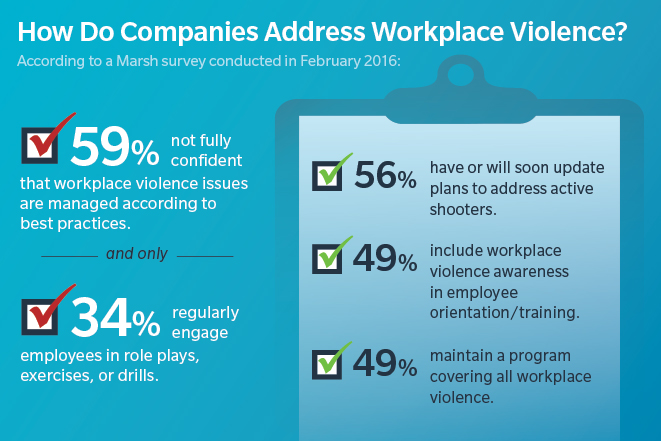1. Which factors contribute to the potential for workplace violence?
Exchanging cash with the public, working where alcohol is served, or serving as a customer representative, as in the retail, restaurant, or hospitality sectors, can put employees at risk. Dealing with volatile, unstable, or medicated people, and their anxious families, can put health care workers in harm’s way. Other factors include the time of day (late-night shifts), location of work (remote or high-crime areas), job or home stress, and emotional state.
2. How can a workplace violence incident affect an organization?
The National Institute for Occupational Safety and Health (NIOSH) estimates that workplace violence costs around $121 billion a year, including lost productivity, days off work, long-term health care costs, legal expenses, property damage, reputational damage, increased security costs, and other financial losses. Lasting and far-reaching consequences can extend to residual fears among employees, clients or customers, visitors, or anyone interacting with the location or organization.
3. How can workplace violence risk be minimized?
First, identify your organization’s risk factors and then take appropriate actions, including establishing a zero-tolerance policy toward workplace violence. Support the policy with a well-written and implemented workplace violence prevention program that comprises engineering and controls as well as training. Workers need to know the policy and understand that all workplace violence claims, no matter the instigator, will be investigated and remedied promptly.
4. What should be included in a workplace violence prevention program?
The program should educate staff about the range of workplace violence issues, communication channels for reporting or discussing incidents, and related policies and procedures. In high-risk professions such as health care, retail, or education, provide regular situational awareness training and tabletop exercises. Ensure preparedness and response plans are integrated, confirm communication protocols within/between locations and key stakeholders such as the police, build employee and victim assistance into response plans, and confirm post-incident reporting obligations are met.
5. What are some best practices for managing workplace violence?
The nature of a workplace violence threat or incident will dictate the actions employees or employers should take. Nonetheless, encourage employees to report and log all threats and incidents and to report violent incidents to local authorities promptly. Victims, whether your employees or other individuals, should be informed of their right to prosecute perpetrators. Hold debriefing sessions where employees share information about how to avoid similar situations and steps they can take to hasten recovery. Also, discuss actual or potential changes in the workplace violence program during regular employee meetings.



